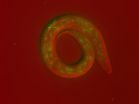(Press-News.org) Cold Spring Harbor, NY – Closely related organisms share most of their genes, but these similarities belie major differences in behavior, intelligence, and physical appearance. For example, we share nearly 99% of our genes with chimps, our closest relatives on the great "tree of life." Still, the differences between the two species are unmistakable. If not just genes, what else accounts for the disparities? Scientists are beginning to appreciate that the timing of the events that happen during development plays a decisive role in defining an organism, which may help to explain how species evolve without the creation of new genes.
Today, a team of scientists at Cold Spring Harbor Laboratory (CSHL) has identified a key regulator of developmental timing. Led by CSHL Assistant Professor Christopher Hammell, the researchers describe how LIN-42, a gene that is found in animals across the evolutionary tree, governs a broad range of events throughout development.
"A great deal of science is focused on understanding how a single gene functions in the cell," says Hammell. "But we are learning that when a gene is active is just as important as what it does."
An organism develops in well-defined stages: nerves and muscles mature before reproductive tissues, for example. The stages unfold sequentially, like movements in a symphony. Played all at once, they would produce a terrible developmental cacophony, but with proper timing, a natural harmony can emerge.
Developmental stages are marked by the activation or repression of a specific and unique complement of genes, like individual notes within movements of a song. The order and duration of when these key developmental genes (or notes) are active (or played) within a given cell is controlled by a class of molecules called microRNAs (miRNAs). A single miRNA gene can control hundreds of other genes at once. If a miRNA turns off these specific genes too early or too late, the organism will suffer severe developmental defects. But little is known about how the activities of these miRNAs are regulated.
In work published today in PLoS Genetics, Hammell and his team describe the genetic approach they used to search for genes that control developmental timing through miRNAs. The team uses a tiny roundworm, called C. elegans, as a simple model for the events that occur during development, even in higher organisms. These worms have a fixed number of cells and each cell division is precisely timed. "It is the perfect model for our work," says Hammell. "It enables us to understand exactly how a mutation affects development, whether maturation is precocious or delayed, by directly observing defects in the timing of gene expression."
The team's search uncovered the gene LIN-42 as a crucial regulator of developmental timing via its pervasive role in controlling miRNAs. "LIN-42 shares a significant amount of similarity to the genes that control circadian rhythms in organisms such as mice and humans," says Roberto Perales, PhD, one of the lead authors of the study. "These are genes that control the timing of cellular processes on a daily basis for you and me. In the worm, these same genes and mechanisms control development, growth, and behavior and this system will provide us with leverage to understand how all of these things are coordinated."
Hammell and his team found that LIN-42 controls the repression of numerous genes in addition to miRNAs. They also discovered that levels of the protein encoded by LIN-42 tend to oscillate over the course of development and form a part of a developmental clock. "LIN-42 provides the organism with a kind of cadence or temporal memory, so that it can remember that it has completed one developmental step before it moves on to the next," says Hammell. "This way, LIN-42 coordinates optimal levels of the genes required throughout development."
This work was supported by the Rita Allen Foundation of which CMH is a Milton E. Cassel Scholar, the National Institutes of Health, and the Robertson Research Fund of Cold Spring Harbor Laboratory.
"LIN-42, the Caenorhabditis elegans PERIOD homolog, negatively regulates microRNA transcription" appears online in PLOS Genetics on July 17, 2014. The authors are: Roberto Perales, Dana King, Christina Aguirre-Chen, and Christopher Hammell. The paper can be obtained online at: http://www.plosgenetics.org
INFORMATION:
About Cold Spring Harbor Laboratory Founded in 1890, Cold Spring Harbor Laboratory (CSHL) has shaped contemporary biomedical research and education with programs in cancer, neuroscience, plant biology and quantitative biology. CSHL is ranked number one in the world by Thomson Reuters for the impact of its research in molecular biology and genetics. The Laboratory has been home to eight Nobel Prize winners. Today, CSHL's multidisciplinary scientific community is more than 600 researchers and technicians strong and its Meetings & Courses program hosts more than 12,000 scientists from around the world each year to its Long Island campus and its China center. For more information, visit http://www.cshl.edu.
In development, it's all about the timing
Scientists identify a gene that controls the timing of precisely ordered events during maturation
2014-07-17
ELSE PRESS RELEASES FROM THIS DATE:
Viral relics show cancer's 'footprint' on our evolution
2014-07-17
Viral relics show cancer’s ‘footprint’ on our evolution Cancer has left its ‘footprint’ on our evolution, according to a study which examined how the relics of ancient viruses are preserved in the genomes of 38 mammal species.
Viral relics are evidence of the ancient battles our genes have fought against infection. Occasionally the retroviruses that infect an animal get incorporated into that animal’s genome and sometimes these relics get passed down from generation to generation – termed ‘endogenous retroviruses’ (ERVs). Because ERVs may be copied to other parts of the ...
When is a molecule a molecule?
2014-07-17
Using ultra-short X-ray flashes, an international team of researchers watched electrons jumping between the fragments of exploding molecules. The study reveals up to what distance a charge transfer between the two molecular fragments can occur, marking the limit of the molecular regime. The technique used can show the dynamics of charge transfer in a wide range of molecular systems, as the scientists around Dr. Benjamin Erk and Dr. Daniel Rolles of DESY and Professor Artem Rudenko of Kansas State University report in the scientific journal Science. Such mechanisms play ...
Pitt-led study suggests cystic fibrosis is 2 diseases, 1 doesn't affect lungs
2014-07-17
PITTSBURGH, July 17, 2014 – Cystic fibrosis (CF) could be considered two diseases, one that affects multiple organs including the lungs, and one that doesn't affect the lungs at all, according to a multicenter team led by researchers at the University of Pittsburgh School of Medicine. The research, published online today in PLOS Genetics, showed that nine variants in the gene associated with cystic fibrosis can lead to pancreatitis, sinusitis and male infertility, but leave the lungs unharmed.
People with CF inherit from each parent a severely mutated copy of a gene ...
Scientists find protein-building enzymes have metamorphosed & evolved new functions
2014-07-17
LA JOLLA, CA AND JUPITER, FL—Scientists at The Scripps Research Institute (TSRI) and Hong Kong University of Science and Technology (HKUST) and their collaborators have found that ancient enzymes, known for their fundamental role in translating genetic information into proteins, evolved myriad other functions in humans. The surprising discovery highlights an intriguing oddity of protein evolution as well as a potentially valuable new class of therapeutic proteins and therapeutic targets.
"These new protein variants represent a previously unrecognized layer of biology—the ...
A new stable and cost-cutting type of perovskite solar cell
2014-07-17
Perovskite solar cells show tremendous promise in propelling solar power into the marketplace. The cells use a hole-transportation layer, which promotes the efficient movement of electrical current after exposure to sunlight. However, manufacturing the hole-transportation organic materials is very costly and lack long term stability. Publishing in Science, a team of scientists in China, led by Professor Hongwei Han in cooperation with Professor Michael Grätzel at EPFL, have developed a perovskite solar cell that does not use a hole-transporting layer, with 12.8% conversion ...
Scientists complete chromosome-based draft of the wheat genome
2014-07-17
MANHATTAN, Kansas — Several Kansas State University researchers were essential in helping scientists assemble a draft of a genetic blueprint of bread wheat, also known as common wheat. The food plant is grown on more than 531 million acres around the world and produces nearly 700 million tons of food each year.
The International Wheat Genome Sequencing Consortium, which also includes faculty at Kansas State University, recently published a chromosome-based draft sequence of wheat's genetic code, which is called a genome. "A chromosome-based draft sequence of the hexaploid ...
Ultrafast X-ray laser sheds new light on fundamental ultrafast dynamics
2014-07-17
MANHATTAN, Kansas — Ultrafast X-ray laser research led by Kansas State University has provided scientists with a snapshot of a fundamental molecular phenomenon. The finding sheds new light on microscopic electron motion in molecules.
Artem Rudenko, assistant professor of physics and a member of the university's James R. Macdonald Laboratory; Daniel Rolles, currently a junior research group leader at Deutsches Elektronen-Synchrotron in Hamburg, Germany, who will be joining the university's physics department in January 2015; and an international group of collaborators ...
No evidence that California cellphone ban decreased accidents, says Colarado University Boulder researcher
2014-07-17
In a recent study, a researcher at the University of Colorado Boulder found no evidence that a California ban on using hand-held cellphones while driving decreased the number of traffic accidents in the state in the first six months following the ban.
The findings, published in the journal Transportation Research Part A: Policy and Practice, are surprising given prior research that suggests driving while using a cellphone is risky. For example, past laboratory studies have shown that people who talk on a cellphone while using driving simulators are as impaired as people ...
Peering into giant planets from in and out of this world
2014-07-17
Lawrence Livermore scientists for the first time have experimentally re-created the conditions that exist deep inside giant planets, such as Jupiter, Uranus and many of the planets recently discovered outside our solar system.
Researchers can now re-create and accurately measure material properties that control how these planets evolve over time, information essential for understanding how these massive objects form. This study focused on carbon, the fourth most abundant element in the cosmos (after hydrogen, helium and oxygen), which has an important role in many types ...
Help wanted: Principals who love change
2014-07-17
DALLAS (SMU) – Training principals for new roles is key to U.S. Department of Education school reforms, according to a new report by SMU researchers. But insufficient training and support for principals to meet the new expectations is leading to a leadership crisis. Twenty percent of newly minted principals leave the profession after two years and seasoned professionals are opting for early retirement.
Education researchers Lee Alvoid and Watt Lesley Black Jr. examine school districts at the forefront of supporting and training effective principals in their report "The ...
LAST 30 PRESS RELEASES:
Many mothers in Norway do not show up for postnatal check-ups
Researchers want to find out why quick clay is so unstable
Superradiant spins show teamwork at the quantum scale
Cleveland Clinic Research links tumor bacteria to immunotherapy resistance in head and neck cancer
First Editorial of 2026: Resisting AI slop
Joint ground- and space-based observations reveal Saturn-mass rogue planet
Inheritable genetic variant offers protection against blood cancer risk and progression
Pigs settled Pacific islands alongside early human voyagers
A Coral reef’s daily pulse reshapes microbes in surrounding waters
EAST Tokamak experiments exceed plasma density limit, offering new approach to fusion ignition
Groundbreaking discovery reveals Africa’s oldest cremation pyre and complex ritual practices
First breathing ‘lung-on-chip’ developed using genetically identical cells
How people moved pigs across the Pacific
Interaction of climate change and human activity and its impact on plant diversity in Qinghai-Tibet plateau
From addressing uncertainty to national strategy: an interpretation of Professor Lim Siong Guan’s views
Clinical trials on AI language model use in digestive healthcare
Scientists improve robotic visual–inertial trajectory localization accuracy using cross-modal interaction and selection techniques
Correlation between cancer cachexia and immune-related adverse events in HCC
Human adipose tissue: a new source for functional organoids
Metro lines double as freight highways during off-peak hours, Beijing study shows
Biomedical functions and applications of nanomaterials in tumor diagnosis and treatment: perspectives from ophthalmic oncology
3D imaging unveils how passivation improves perovskite solar cell performance
Enriching framework Al sites in 8-membered rings of Cu-SSZ-39 zeolite to enhance low-temperature ammonia selective catalytic reduction performance
AI-powered RNA drug development: a new frontier in therapeutics
Decoupling the HOR enhancement on PtRu: Dynamically matching interfacial water to reaction coordinates
Sulfur isn’t poisonous when it synergistically acts with phosphine in olefins hydroformylation
URI researchers uncover molecular mechanisms behind speciation in corals
Chitin based carbon aerogel offers a cleaner way to store thermal energy
Tracing hidden sources of nitrate pollution in rapidly changing rural urban landscapes
Viruses on plastic pollution may quietly accelerate the spread of antibiotic resistance
[Press-News.org] In development, it's all about the timingScientists identify a gene that controls the timing of precisely ordered events during maturation


